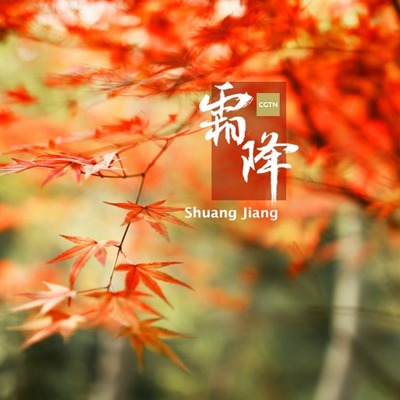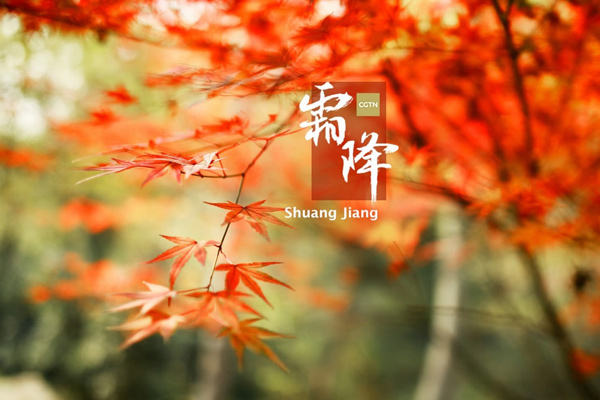

Frost's Descent [Photo/CGTN]
The 24 solar terms play a very important role in Chinese culture, as they show how the Chinese people used the calendar to manage the relationship between people and nature. They also make a strong association between the change of seasons (季节变化,jì jié biàn huà) and agricultural production (农业生产,nóng yè shēng chǎn), diet (饮食,yǐn shí), philosophy on health (健康哲学,jiàn kāng zhé xué), and folk culture (民俗文化,mín sú wén huà).
Learning and understanding the 24 solar terms can be said to be fundamental to really knowing the Chinese culture (中国文化,zhōng guó wén huà), lifestyle (生活方式,shēng huó fāng shì), and way of thinking (思维方式,sī wéi fāng shì).
What Are the 24 Solar Terms?
You may have noticed that the English name "24 Solar Terms" doesn't quite match up to the Chinese name for them. 24节气 (èr shí sì jié qì) could be more literally translated as "the 24 periods of weather," and were first established by the Chinese people to keep track of the changes of seasonal weather and manage the relationship between people and nature. They originally didn't base them off of the sun, but instead according to the clockwise rotation of the Big Dipper's (北斗七星,běi dǒu qī xīng) handle in the night sky, since each full rotation of the handle marked the passing of a year.
Autumn Solar Terms & Folk Culture
Autumn includes the following six solar terms:
立秋 (lì qiū) - Beginning of Autumn
处暑 (chù shǔ) - End of Heat
白露 (bái lù) - White Dew
秋分 (qiū fēn) - Autumn Equinox
寒露 (hán lù) - Cold Dew
霜降 (shuāng jiàng) - Frost's Descent
立秋 (lì qiū) is the 13th of the 24 solar terms, and symbolizes the beginning of autumn. This day has a custom called 贴秋膘 (tiē qiū biāo). It reflects the standard held by Chinese people of the past towards judging health conditions. In the past, on the day of 立秋 (lì qiū), it was common for people to greet others using their weight, comparing their current weight to their weight on 立夏 (lì xià). If they had lost weight, they were called 苦夏 (kǔ xià) - bitter summer, but if they'd gotten skinny, then it was noted they needed to eat more meat to make up for it. The means by which they would regain the weight is 贴秋膘 (tiē qiū biāo). 贴 (tiē), in this case, means "to add", while 膘 (biāo) refers to meats that are higher in fat.
Another particularly interesting solar term is 秋分 (qiū fēn) - Autumn Equinox. The modern-day 中秋节 (zhōng qiū jié) - Moon Festival - developed from the historical 祭月节 (jì yuè jié), a festival in which sacrifices were offered to the moon. However, because the moon is not necessarily full on the day of 秋分(qiū fēn), 中秋节(zhōng qiū jié) is now fixed on the 15th day of the 8th month of the lunar calendar.
The final two solar terms of autumn are 寒露 (hán lù) - Cold Dew - and 霜降 (shuāng jiàng) - Frost's Descent. From these two terms, we can see clearly that the temperature is quickly getting colder at this time of year. During this period, the primary Chinese folk practice is 赏秋叶 (shǎng qiū yè) - admiring the autumn leaves. There is a famous poem that almost all Chinese people know that is worth learning: 霜叶红于二月花 (shuāng yè hóng yú èr yuè huā) - the frost-covered leaves are more red than the flowers of spring. Beyond admiring the autumn leaves, the other folk practices associated with this time of year have to do with eating; such as eating crab, sesame, and flower cakes, as well as drinking chrysanthemum tea. Additionally, because 重阳节 (chóng yáng jié) - Double Ninth Festival (the 9th day of the 9th month of the lunar calendar) - also falls during this time, people will also take time to view the blossoming chrysanthemums (菊花 jú huā).
To be continued
Source: Yoyo Chinese
If you have any problems with this article, please contact us at app@chinadaily.com.cn and we'll immediately get back to you.